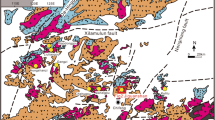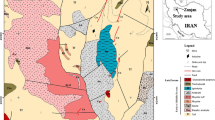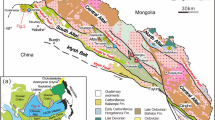Abstract
The Kighal porphyry Cu–Mo prospect is located to the north of Varzeghan, NW Iran. It is hosted by a quartz monzonite porphyry stock that intruded Eocene volcanic rocks. Hydrothermal activity and associated liquid–vapor immiscibility caused hydro-fracturing and generation of various kinds of quartz–sulfide veinlets. Almost all quartz crystals within these veinlets are fluid inclusion-rich. The entrapped fluids are of four main compositional types: mono-phase vapor-rich, two-phase liquid-rich, two-phase vapor-rich, and multiphase (L + V + S). Based on microthermometric studies of fluid inclusions, the salinity ranges from 1.4 to 70 wt% NaCl equivalent, while most of the values cluster between 35 and 70 wt% NaCl equiv. The T H values of two-phase inclusions homogenizing into liquid and vapor states range between 180–440 and 360–540 °C, respectively. Most of the multiphase inclusions homogenize by halite dissolution with T m(NaCl) varying from 360 to 600 °C, while some of them homogenize by simultaneous disappearance of halite and vapor which show a wider range of T H (300–600 °C). Inclusions with T m(NaCl) ≫ T H(L–V) and higher salinity values may have suffered necking down and/or liquid loss or trapped solid halite crystals. The approximate depth of mineralization and entrapment of the studied inclusions is estimated about >1.0 to 2 km. The principal process responsible for mineralization was liquid–vapor immiscibility and consequent supersaturation of the hydrothermal fluids. Based on stable isotope analyses carried out on quartz–sulfide veinlets, δ18O (5.4–5.8 ‰) and δD (−77 to −61 ‰) values of the ore-bearing fluids, as well as the δ34S value of a representative pyrite sample (1.3 ‰) are consistent with a predominantly magmatic source.










Similar content being viewed by others
References
Agha Nabaty E (2004) Geology of Iran. Geological survey and mineral exploration organization of Iran, Tehran
Ahmad SN, Rose AW (1980) Fluid inclusions in porphyry and skarn ore at Santa Rita, New Mexico. Econ Geol 75:229–250
Audétat A, Günther D (1999) Mobilization and H2O-loss from fluid inclusions in natural quartz crystals. Contrib Mineral Petrol 137:1–14
Baker T (2002) Emplacement depth and carbon dioxide-rich fluid inclusions in intrusion-related gold deposits. Econ Geol 97:1111–1117
Berberian M, King GCP (1981) Towards paleogeography and tectonic evolution of Iran. Can J Earth Sci 18:210–265
Beyer SR, Kyser K, Hiatt EE, Polito PA, Alexande P, Hoksbergen K (2012) Basin evolution and unconformity-related uranium mineralization: the Camie River U prospect, Paleoproterozoic Otish Basin, Quebec. Econ Geol 107:401–425
Bodnar RJ (1993) Revised equation and table for determining the freezing point depression of H2O–NaCl solutions. Geochim Cosmochim 57:683–684
Bodnar RJ (1994) Synthetic fluid inclusions: XII. The system H2O-NaCl. Experimental determination of the halite liquidus and isochors for a 40 wt% NaCl solution. Geochim Cosmochim 58:1053–1063
Bodnar RJ (2003) Introduction to fluid inclusions. In: Samson I Anderson A Marshall D (eds) Fluid inclusion-analysis and interpretation, Mineral Assoc Canada, Short Course Series 32:1–9.
Bodnar RJ, Beane RE (1980) Temporal and spatial variations in hydrothermal fluid characteristics during vein filling in preore cover overlying deeply buried porphyry copper-type mineralization at Red Mountain, Arizona. Econ Geol 75:876–893
Borisenko AS (1977) Study of the salt composition of solutions in gas–liquid inclusions in minerals by cryometric method. Sov Geol Geophys 18:11–19
Bouzari F, Clark AH (2006) Prograde evolution and geothermal affinities of a major porphyry copper deposit: the Cerro Colorado hypogene protore, I Región, northern Chile. Econ Geol 101:95–134
Calagari AA (1997) Geochemical, stable isotope, noble gas and fluid inclusion studies of mineralization and alteration at Sungun porphyry copper deposit, East-Azarbaidjan, Iran: implication for genesis. Dissertation, University of Manchester.
Calagari AA (2003) Stable isotope (S, O, H and C) studies of phyllic and potassic-phyllic alteration zones of the porphyry copper deposit at Sungun, East-Azarbaidjan, Iran. J Asian Earth Sci 21:767–780
Calagari AA (2004a) Geology and fracture-related hypogene hydrothermal alteration and mineralization of porphyry copper deposit at Sungun, Iran. J Geol Soc India 64:595–618
Calagari AA (2004b) Fluid inclusion studies in quartz veinlets in the porphyry copper deposit at Sungun, East-Azarbaidjan, Iran. J Asian Earth Sci 23:179–189
Chambefort I, Dilles JH, Longo AA (2013) Amphibole geochemistry of the Yanacocha Volcanics, Peru: evidence for diverse sources of magmatic volatiles related to gold ores. J Petrol 54:1017–1046
Chen H, Kyser TK, Clark AH (2011) Contrasting fluids and reservoirs in the contiguous Marcona and Mina Justa iron oxide–Cu (−Ag–Au) deposits, south-central Peru. Miner Depos 46:677–706
Clayton RN, Mayeda TK (1963) The use of bromine pentafluoride in the extraction of oxygen from oxides and silicates for isotopic analysis. Geochim Cosmochim 27:43–52
Cline JS, Bodnar RJ (1991) Can economic porphyry copper mineralization be generated by a typical calc-alkaline melt? J Geophys Res 96:8113–8126
Cline JS, Bodnar RJ (1994) Direct evolution of brine from a crystallizing silicic melt at the Questa, New Mexico, molybdenum deposit. Econ Geol 89:1780–1802
Cloke PL, Kesler SE (1979) The halite trend in hydrothermal solutions. Econ Geol 74:1823–1831
Craig H (1961) Isotopic variations in meteoric waters. Science 133:1702–1703
den Kerkhof V, Hein U (2001) Fluid Inclusion petrography. Lithos 55:27–47
Etminan H (1978) Fluid inclusion studies of the porphyry copper ore bodies at Sar-Cheshmeh, Darreh Zar and Mieduk (Kerman region, southeastern Iran) and porphyry copper discoveries at Miduk, Gozan, and Kighal, Azarbaijan region (northwestern Iran). Int Assoc Genes Ore Depos 5th Symposium, Snowbird, Utah, Proceedings, 88.
Faure G (1986) Principles of isotope geology. Wiley, New York
Giggenbach WF (1992) Isotopic shifts in waters from geothermal and volcanic systems along convergent plate boundaries and their origin. Earth Planet Sci Lett 113:495–510
Goldstein RH (2003) Petrographic analysis of fluid inclusions. In: Samson I, Anderson A Marshall D (eds) Fluid inclusion-analysis and interpretation. Mineral Assoc Canada, Short Course Series 32:9–54.
Gonzalez-Partida E, Levresse G (2003) Fluid inclusion evolution at the La Verde porphyry copper deposit, Michocan, Mexico. J Geochem Explor 78–79:623–626
Hedenquist JW, Arribas AJ, Reynolds TJ (1998) Evolution of an intrusion-centered hydrothermal system: Far Southeast-Lepanto porphyry and epithermal Cu–Au deposits, Philippines. Econ Geol 93:373–404
Hezarkhani A, William-Jones AE (1998) Controls of alteration and mineralization in the Sungun porphyry copper deposit, Iran: evidence from fluid inclusions and stable isotopes. Econ Geol 93:651–670
Kranz RL (1983) Micro-cracks in rocks: a review. Tectonophysics 100:449–480
Landtwing MR, Furrer C, Redmond PB, Pettke T, Guillong M, Heinrich CA (2010) The Bingham Canyon porphyry Cu–Mo–Au deposit: III. Zoned copper-gold ore deposition by magmatic vapor expansion. Econ Geol 105:91–118
Lowenstern JB (2001) Carbon dioxide in magmas and implications for hydrothermal systems. Miner Depos 36:490–502
Matsuhisa Y, Goldsmith JR, Clayton RN (1979) Oxygen isotope fractionation in the system quartz–albite–anorthite–water. Geochim Cosmochim 43:1131–1140
Mavrogenes JA, Bodnar RJ (1994) Hydrogen movement into and out of fluid inclusions in quartz: experimental evidence and geological implications. Geochim Cosmochim 58:141–148
Nabavy H (1976) An introduction to the geology of Iran. Geological survey organization of Iran, Tehran
Ohmoto H, Rye RO (1979) Isotopes of sulfur and carbon. In: Barnes HL (ed) Geochemistry of hydrothermal ore deposits, 2nd edn. Wiley, New York, pp 509–567
Pirajno F (2009) Hydrothermal processes and mineral systems. Springer, Geological Survey of Western Australia.
Prokofiev VY, Garofalo PS, Bortnikov NS, Kovalenker VA, Zorina LD, Grichuk DV, Selektor SL (2010) Fluid inclusion constraints on the genesis of gold in the Darasun District (eastern Transbaikalia), Russia. Econ Geol 105:395–416
Roedder E (1978) Silicate liquid immiscibility in magmas and in the system of K2O–FeO–Al2O3–SiO2, an example of serendipity. Geochim Cosmochim 42:1597–1617
Roedder E (1984) Fluid inclusions. Mineral Soc America, Review in Mineralogy, 12.
Roedder E, Bodnar RJ (1980) Geologic pressure determinations from fluid inclusion studies. Annu Rev Earth Planet Sci 8:261–301
Rusk BG, Reed MH, Dilles JH, Klemm LM, Heinrich CA (2004) Compositions of magmatic hydrothermal fluids determined by LA-ICP-MS of fluid inclusions from the porphyry copper–molybdenum deposit at Butte, MT. Chem Geol 210:173–199
Rusk BG, Reed MH, Dilles JH (2008) Fluid inclusion evidence for magmatic–hydrothermal fluid evolution in the porphyry copper–molybdenum deposit at Butte, Montana. Econ Geol 103:307–333
Seedorff E, Einaudi M (2004) Henderson porphyry molybdenum system, Colorado: II. Decoupling of introduction and deposition of metals during geochemical evolution of hydrothermal fluids. Econ Geol 99:39–72
Seedorff E, Dilles JH, Proffett JM, Einaudi MT, Zurcher L, Stavast WJA, Johnson DA, Barton MD (2005) Porphyry deposits: characteristics and origin of hypogene features. Econ Geol 100:251–298
Shahabpour J (1982) Aspects of alteration and mineralization at the Sar-Cheshmeh copper-molybdenum deposit, Kerman, Iran. Dissertation, University of Leeds.
Sharp ZD, Atudorei V, Durakiewicz T (2001) A rapid method for determination of hydrogen and oxygen isotope ratios from water and hydrous minerals. Chem Geol 178:197–210
Shepherd TJ, Rankin AH, Alderton DHM (1985) A practical guide to fluid inclusion studies. Blackie, Glasgow
Shinohara H and Kazahaya K (1995) Degassing processes related to magma chamber crystallization. In: Thompson JFH (ed) Magmas, Fluids and Ore Deposits. Mineral Assoc Canada, Short Course Series 23:47–70.
Sillitoe RH (2000) Gold-rich porphyry deposits: descriptive and genetic models and their role in exploration and discovery. SEG Rev 13:315–345
Simmonds V (2010) Studies of geology, geochemistry and genesis of porphyry-type copper mineralization in Kighal and Barmolk areas, north of Varzeghan, East-Azarbaidjan, Iran. Dissertation, University of Tabriz.
Simmonds V (2013) Geochemistry and petrogenesis of an adakitic quartz-monzonitic porphyry stock and related cross-cutting dike suites, Kighal, northwest Iran. Int Geol Rev 55:1126–1144
Simmonds V, Calagari AA, Moayyed M, Jahangiri A (2010) Petrologic and petrogenetic study of Kighal porphyry stock (north of Varzeghan, East- Azarbaidjan province, NW Iran). Iran J Geol 13:47–60
Simmonds V, Calagari AA, Moayyed M, Jahangiri A (2012) The study of porphyry-type alteration zones and geochemical behavior of the trace and rare earth elements within them in Kighal, north of Varzeghan, East-Azarbaidjan, Iran. Iran J Crystallogr Miner 19:565–578
Sterner SM, Hall DL, Bodnar RJ (1988) Synthetic fluid inclusions: V. Solubility relations in the system NaCl–KCl–H2O under vapor-saturated conditions. Geochim Cosmochim 52:989–1005
Taylor HP Jr (1979) Oxygen and hydrogen isotope relationships in hydrothermal mineral deposits. In: Barnes HL (ed) Geochemistry of hydrothermal ore deposits, 2nd edn. Wiley, New York, pp 236–277
Taylor BE (1992) Degassing of H2O from rhyolite magma during eruption and shallow intrusion, and the isotopic composition of magmatic water in hydrothermal system. Geol Surv Jpn Rep 279:190–195
Ulrich T, Guenther D, Heinrich CA (2001) The evolution of a porphyry Cu–Au deposit, based on LA-ICP-MS analysis of fluid inclusions: Bajo de la Alumbrera, Argentina. Econ Geol 96:1743–1774
Vollbrecht A (1989) Microriβ-Analyse im KTB-Datenerhebung U-Tisch Mikroskopie. Unpublished report IGDL, Gottingen
Wanhainen C, Broman C, Martinsson O (2003) The Aitik Cu–Au–Ag deposit in northern Sweden: a product of high salinity fluids. Miner Depos 38:715–726
Wilkinson JJ (2001) Fluid inclusions in hydrothermal ore deposits. Lithos 55:229–272
Wilson JWJ, Kesler SE, Cloke PL, Kelly WC (1980) Fluid inclusion geochemistry of the Granisle and Bell porphyry copper deposits, British Columbia. Econ Geol 75:45–61
Zarnab Ekteshaf Consultant Engineers (2007) Geologic and alteration studies at Kighal and Barmolk areas in 1:5000 scale. Iranian national copper industries company, Tehran
Zhang YG, Frantz JD (1987) Determination of the homogenization temperatures and densities of supercritical fluids in the system NaCl–KCl–CaCl2–H2O using synthetic fluid inclusions. Chem Geol 64:335–350
Zhang D, Xu G, Zhang W, Golding SD (2007) High salinity fluid inclusions in the Yinshan polymetallic deposit from the Le–De metallogenic belt in Jiangxi Province, China: their origin and implications for ore genesis. Ore Geol Rev 31:247–260
Acknowledgements
The authors would like to express their thanks and appreciations to Prof. John Dilles and the anonymous reviewers for their valuable reviews and helpful recommendations which greatly promoted the manuscript.
Author information
Authors and Affiliations
Corresponding author
Rights and permissions
About this article
Cite this article
Simmonds, V., Calagari, A.A. & Kyser, K. Fluid inclusion and stable isotope studies of the Kighal porphyry Cu–Mo prospect, East-Azarbaidjan, NW Iran. Arab J Geosci 8, 437–453 (2015). https://doi.org/10.1007/s12517-013-1130-z
Received:
Accepted:
Published:
Issue Date:
DOI: https://doi.org/10.1007/s12517-013-1130-z




